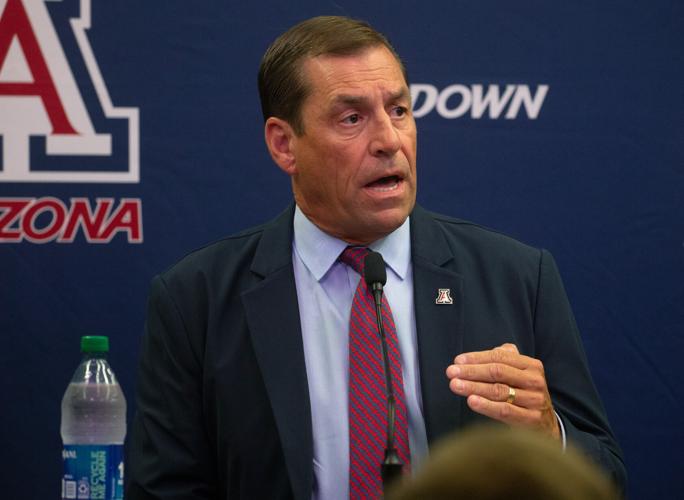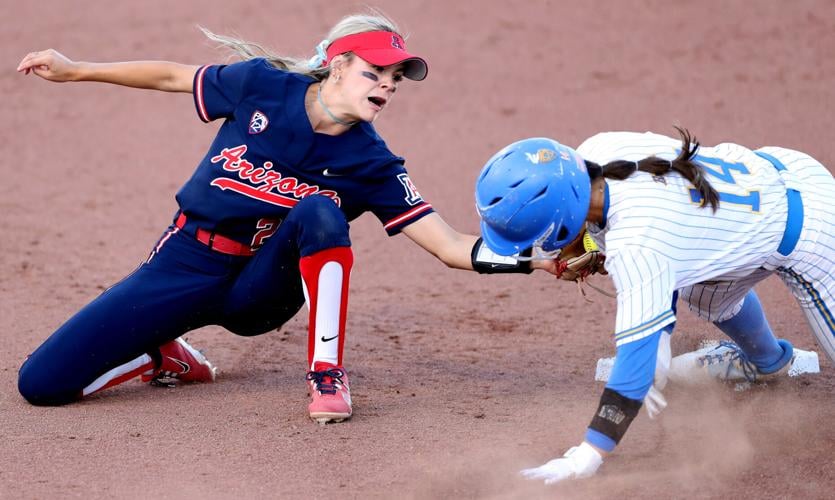One of the walls in Dave Heeke’s office at McKale Center features a montage of black-and-white photos of the University of Arizona campus and long-ago UA athletic events. The words “excellence,” “legacy” and “tradition” — in silver, all-caps lettering — border the artwork, which includes an image of a 1909 Thanksgiving Day football game.
“That’s the good stuff,” said Heeke, who’s been Arizona’s vice president and director of athletics since February 2017.
Not that all the stuff that’s transpired in college athletics since then — the advent of the transfer portal, NIL, conference realignment and the impeding dissolution of the Pac-12 Conference — is necessarily bad. But it’s been a constant stream of changes, many seismic in scope, and they’ve barely allowed Heeke and his staff a moment to breathe.
When he sat down with the Star for an hour-long interview Thursday, Heeke was working to finalize the UA’s transition team as the school plays its final season in the Pac-12 before officially moving to the Big 12 next summer. It’s a massive undertaking. Heeke is striving to get ahead of it.

Athletic director Dave Heeke speaks during a news conference about Arizona's move to the Big 12 Conference at Arizona Stadium on Aug. 7.
“I'm just big into knowing absolutely as much as we can, so that we are ready to walk through that door and be fully ready to jump on the ship, as I say, and be really competitive,” Heeke said. “I don't want to try to figure it out."
Meanwhile, the Wildcats have games to play as full-time, departing members of the Pac-12. The women’s soccer and volleyball teams have begun their campaigns. Football kicks off next Saturday against NAU.
In Part 1 of a two-part Q&A, Heeke discussed the monumental move to the Big 12 and all that it entails. The conversation has been lightly edited.
Has there been any word yet about scheduling with the Big 12 for football and basketball?
A: “Well, you got 16 (schools). I've been to one athletic directors meeting in person. We were in Dallas together. Talked about it in a global sense. Really tried to start focusing in on football. I also sit on the subcommittee (for) Big 12 basketball. So we're dealing with scheduling right now, just started, had a conference call today about how to schedule going forward — 18-game conference schedules, 20-game conference schedules, potential other special events that we might want to be involved in and how that would impact (it).
“I think football will come soon. We're all trying to figure out: How will we schedule that? Divisional? Regionally? Scheduling pods? What's best? There are easy opinions, quick ones, but then they also always have a domino effect: You don't play someone for a long time or ... you're gonna have to go across the country too many times. That's what's great about this move, the regionality of it. There's the ability to keep this thing together, keep expenses to the right levels, do the right things for the student-athletes. That was all part of that decision. It works.
“I don't foresee divisions. ... I see one league. You may play certain groups more than others ... but I don't really see a divisional concept in the Big 12.”
You guys are scheduled to play Kansas State in non-conference football games in 2024 and ’25. Is there talk of keeping those games because it’s such a short turnaround?
A: “We’re taking a look at all that. That was really something we've looked at for a while, knowing that this could potentially come. One of the considerations is keeping them as a non-con. Others (include), what else could happen around the country? What other games could shake down?
“The problem is, there's not an inventory of games less than one year from now to put on a schedule. And then there's multiple teams. You've got ourselves, Utah and I believe it's Colorado that all have Big 12 opponents over the next year and two years for sure. And we have (several) series. We go Kansas State, BYU (2026 and ’27), Texas Tech (2034). So we'll have to identify all that and try to work through that.”
What has your analysis shown in terms of the difference in distance, cost, time, etc., in Pac-12 vs. Big 12 travel?
A: “Let me preface this by saying we're drilling down deeper on all the analytics. But our initial review, on average, when you look at commercial travel across all of the trips, it equals out to about 45 minutes to an hour more travel time (each way) for a student-athlete. On the charter side, it's maybe 30-40 minutes more on average.
“We've got direct flights to Denver, Salt Lake, Houston, Dallas. We looked at the connections between other cities out of Tucson. Do you need to modify and potentially say if we're going to go on a trip, would it be worthwhile to drive to Phoenix the night before, spend the night, get on an airplane (and) go direct to Cincinnati, go direct to Orlando?
“Depending on how you schedule, how you modify that and regionalize that, there's actually a case to be made that it would be fewer travel hours, and the expense would be less than what we are currently doing. We're shifting four potential trips, pretty lengthy trips, to the Northwest that are challenging.
“There might be some adjustments with how we travel ... for the wear and tear on the student-athletes. And we’ve always got to take into consideration academics.”
What kind of feedback have you gotten from coaches, student-athletes and their parents about this whole situation?
A: “I have received no negative feedback whatsoever. (But) let me step back.
“(I have spent) 26 years in the Pac-10/Pac-12 Conference. I grew up in the Midwest watching the Rose Bowl. I thought those were the two greatest conferences ever. The Big Ten and the Pac-10 — Pac-8, I go back that far. That was all I knew. So for me personally, it's a little bittersweet.
“When (you) talk about relationships and memories and rivalries and programs that define sport, this league defines softball. UCLA and Arizona made softball what it is today. It's kind of hard to believe that, somehow, we're going to dismantle that kind of stuff.

Arizona shortstop Logan Cole, left, can’t get the tag on as UCLA’s Kelli Godin hooks into second with a stolen base in the fifth inning of their Pac 12 Softball Tournament game at Hillenbrand Stadium on May 11, 2023.
“Is there some sorrow and grief and a little bit of pain? Yeah. And we're gonna respect all of that. I don't ever want to minimize the appreciation and the value and the position that the Pac-8, -10 and -12 has had through the years, because it's powerful.
“Are people a little nostalgic? Is it different? Yes. But when we talk to our student-athletes, they're excited about new opportunities, they're excited to compete against new teams, challenge for championships in a different league. They're really looking forward to that. Coaches are really very open-minded to it.
“I think there are opportunities the way it's structured that we can manage all of those things that seem to be national narratives — about why conference realignment is so bad (and) no one thought about student-athletes. I don't think that's fully true in our case; we did. We can offer a really good experience. A different experience.”
What is the ultimate outcome of conference realignment? Is it possible that football will split off someday and the other sports will go back to where they were before?
A: “I think that makes some sense. But we have different media packages that are on different timelines that are tied to revenues and resources that provide our ability to run our programs. It's hard to get everybody around one table and in one room to agree — like, let's just cut the line and go. But we're headed towards another sea change in college athletics, and I hope it's the right kind of change that allows it to continue to prosper and serve in the way it's done in the past.
“I'm not a proponent of paying players. I'm totally a proponent of sharing more resources and providing more opportunities. But I do think that would be the end of college athletics as we know it.”
There’s a difference between student-athletes becoming employees and receiving money through NIL. How do you feel about the support your athletic department has right now in the NIL space?
A: “We embrace the NIL concept and think it's part of the competitive landscape. It came on filled with challenges and converging issues that cause it to be very problematic. When you put a transfer portal in and you put in NIL and no restrictions on either, no guidelines on either, that's a disaster. And that's what we're faced with right now — bidding wars and these kinds of crazy things that are happening outside of our controls in athletics through these third-party entities that are helping to move dollars to student-athletes. That's troubling.
“But I do believe we have a mechanism here. We are very active in it. Our collectives have been very supportive.
"There's always more somewhere (else). And I question whether (some) student-athletes are truly making those decisions based on what's right for them or if it's just ... an economic decision. Some of these decisions to transfer are not in their best interest.
"But that's their choice. We'll just move on. We're gonna just keep building programs and doing it the right way.”
“We thought the future was gonna be brighter as a member of the Big 12. … I think this is a very exciting deal for us.” — Arizona president Robert Robbins; Video by Justin Spears/Arizona Daily Star






